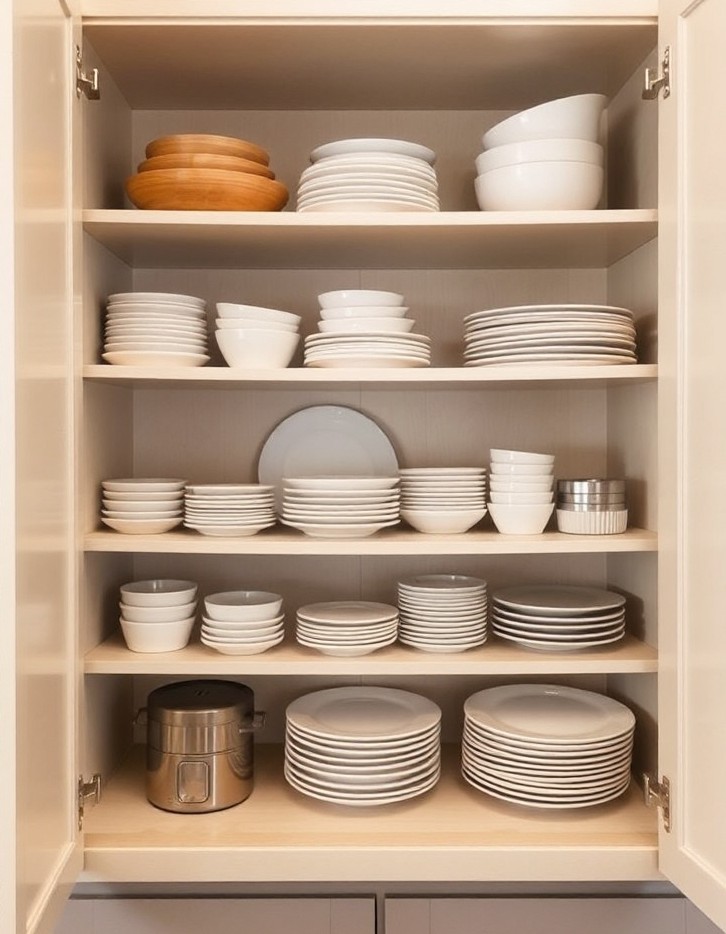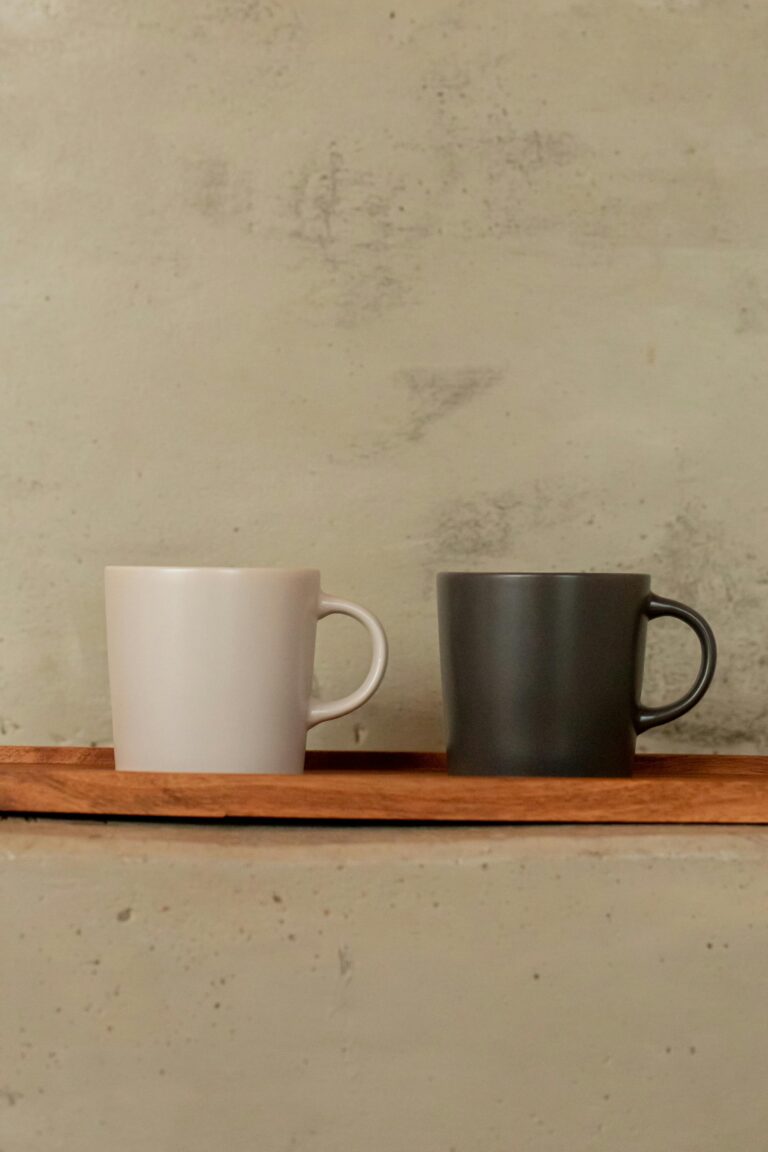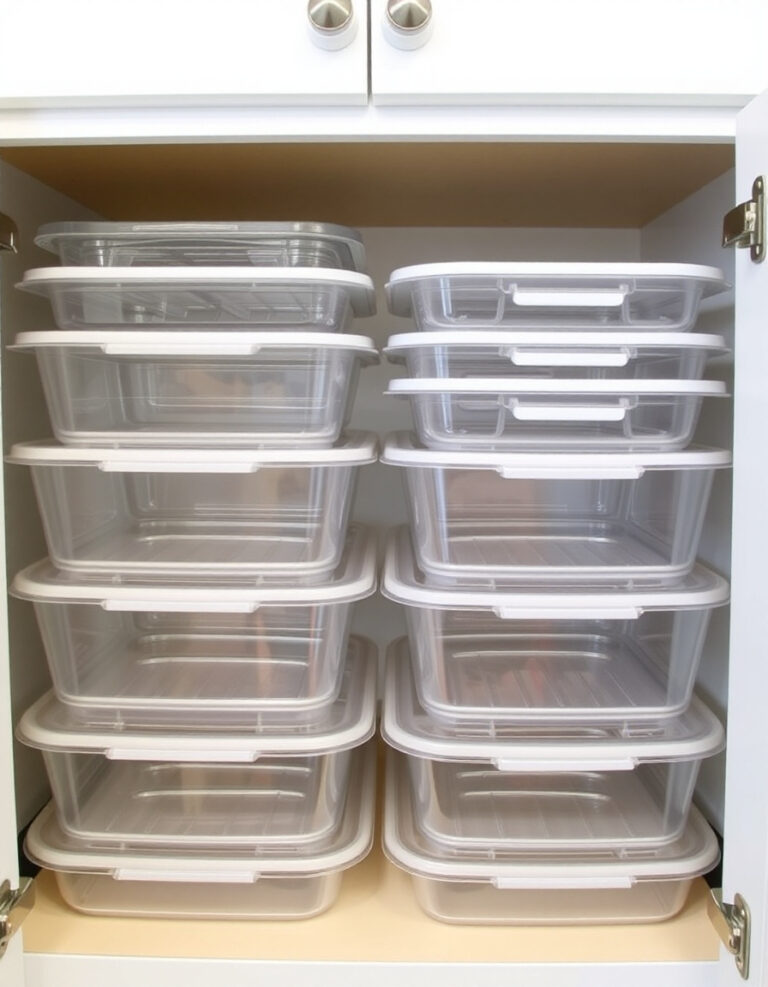The way you arrange your kitchen cabinets can affect how smoothly your cooking routine flows. When items you use daily are within easy reach, you spend less time searching and more time cooking. This approach creates a layout that works with your habits, not against them.
Why Frequency-Based Organization Works for Kitchen Storage

Organizing by how often you use things puts the most practical items in the most accessible spots.
It’s a simple concept: things you grab every day deserve prime real estate. Your coffee mug shouldn’t hide behind the punch bowl you use twice a year.
This method also helps you spot what you actually need versus what’s just taking up space.
1. Sort Everything in Your Kitchen Cabinets by Usage Frequency
Pull everything out and create three groups: daily, weekly, and rarely used.
Daily items might include plates, glasses, cooking oil, and your favorite pan. Weekly items could be mixing bowls, baking sheets, or specialty spices. Rarely used items are things like that waffle maker gathering dust.
Be honest about what you actually reach for. If you haven’t touched something in six months, it probably belongs in the rarely-used category.
2. Map Your Kitchen Cabinet Zones Based on Reach and Access
Not all cabinet space is created equal when it comes to accessibility.
The eye-level zone (roughly between your waist and shoulders) is your prime territory. This is where daily essentials should live. Lower cabinets work well for heavier items you use regularly, like pots and mixing bowls.
Upper cabinets above eye level can store things you need weekly but not daily. The very top shelves and back corners become homes for rarely-used items.
3. Place Daily-Use Items in the Most Accessible Kitchen Cabinet Spots
Your most-used items deserve the easiest access points.
Think about your morning routine. If you make coffee daily, mugs should sit at eye level near the coffee maker. Everyday plates and glasses belong in cabinets close to both the dishwasher and dining area.
Cooking oils, salt, pepper, and frequently used spices should live near the stove in easy-reach zones.
4. Store Weekly Items in Secondary Kitchen Cabinet Locations
Items you use a few times a week can occupy the next-best spots.
These might include baking supplies or extra serving bowls. Middle shelves in upper cabinets work well here, as do the front sections of lower cabinets.
You want these items accessible but not taking up prime real estate that daily essentials need.
5. Group Similar Kitchen Cabinet Items Together by Function
Frequency matters, but so does keeping related items together.
All baking supplies might live in one zone, even if you use flour daily and cake decorating tips monthly. Coffee and tea supplies can share a cabinet near the coffee maker. This dual approach—organizing by both frequency and function—creates an intuitive system.
You’ll naturally know where to look for what you need.
6. Adjust Your Kitchen Cabinet Layout Based on Your Cooking Habits
Your organization should reflect how you actually use your kitchen.
If you bake every weekend, baking supplies deserve better placement than in a household that rarely uses the oven. Someone who meal preps might prioritize storage container access differently than someone who cooks small batches.
Track what you reach for over a week and adjust accordingly.
7. Use Drawer Dividers and Shelf Risers to Maximize Kitchen Cabinet Space
Smart organizers can help maintain your frequency-based system.
Shelf risers double your usable space in upper cabinets, making it easier to separate daily mugs from weekly wine glasses. Drawer dividers keep frequently used utensils organized and easy to grab.
Turning trays work well in corner cabinets for items you need regularly but that sit in awkward spaces.
Things That Can Make Kitchen Cabinet Organization Harder
Some common mistakes can undo your organization efforts.
Storing items in the first open spot rather than thinking about frequency creates unnecessary searching. Keeping duplicate items when you only need one takes up valuable space. Letting things migrate back to random locations defeats the purpose of organizing in the first place.
Another challenge is holding onto items you never use just because they were gifts or seemed useful when you bought them.
FAQs
How do you decide what goes where in kitchen cabinets?
Start by tracking what you actually use over a typical week. Items you reach for daily should occupy the easiest-to-access spaces between waist and shoulder height.
Things you use weekly can sit in secondary locations. Rarely used items belong in harder-to-reach spots like high shelves or back corners.
How often should you reorganize kitchen cabinets?
A full reorganization might make sense once or twice a year, or when your cooking habits change significantly. Quick adjustments can happen more often as you notice certain items becoming harder or easier to access.
The goal is maintaining a system that works, not constantly reshuffling everything. Small tweaks tend to work better than frequent overhauls.
What’s the best way to store rarely used kitchen items?
Place rarely used items in the least accessible cabinet spaces, like top shelves or deep back corners. Consider storing some items outside the kitchen if space is limited—a basement, garage, or storage closet might work for things you use once or twice a year.
Make sure these items are still reachable when needed. Label boxes or bins to help you find specific items without digging through everything.
Should kitchen cabinet organization prioritize frequency or function?
Both matter, and the best systems combine the two approaches. Start with frequency to determine general zones, then group similar items together within those zones.
For example, all baking supplies might share one area, but flour you use daily sits more accessible than decorating tips you rarely need. This combined approach tends to feel most intuitive in daily use.
Can you organize kitchen cabinets without buying storage products?
Yes, frequency-based organization works with or without organizers. The core principle is simply placing items based on how often you use them.
Storage products like shelf risers or Turning trays can make the system work better in tricky spaces. But start with the basic sorting and placement strategy first, then add organizers only where they solve specific problems.
What’s the fastest way to start organizing kitchen cabinets by frequency?
Begin with just one or two cabinets that hold your most-used items. Move daily essentials to the most accessible spots in those cabinets.
This focused approach shows immediate results without the overwhelm of tackling the entire kitchen at once. You can gradually work through other cabinets as time allows.
How do you maintain kitchen cabinet organization over time?
Put items back in their designated spots after each use. Do a quick reset every few weeks to catch anything that’s migrated to the wrong location.
Reassess your system when you notice yourself consistently reaching for certain items that aren’t in convenient spots. Small adjustments along the way prevent the need for major reorganizations.
Wrapping Up Your Kitchen Cabinet Organization
Organizing your kitchen cabinets by frequency of use can create a more efficient cooking space. When daily essentials sit within easy reach and rarely used items move to back corners, your kitchen starts working with your routines.
Give this approach a try and adjust it to fit how you actually cook. You might find those small changes make your time in the kitchen feel a bit smoother.



